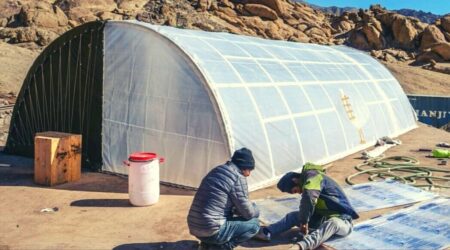Everyday Ayurveda column by Dr. Bhaswati Bhattacharya
Many people know they were not good scholars during their schooling. Unable to memorize, unable to calculate, they remain mediocre today. Most become content with their low level of connection with the vast knowledge on the planet. They look around and see others with the same level of I-don’t-get-it, and accept that as the “normal.” They live within their limited shell of ability, inflating themselves when they feel inadequate, but generally becoming accustomed to the boundary between got-it and don’t-get-it, which then creates the material boundary in today’s world between the have’s and have-not’s. They become addicted to substances to forget. They wander into territories forbidden by their minds.
What differentiates who has an ability to learn? Is it genetic? Is it repairable? Generations of education experts in the west explore what makes a student learn, hoping to coax scholarly behavior through their efforts. Nutrition, experiential learning, and sensory preference for learning through visual, auditory, or kinesthetic cues are emphasized. The role of parents, the role of childhood violence, the role of an early age tutor or schoolteacher have been offered as key factors in the development of the ability to learn. Psychologists, child development experts, pediatricians, and a host of professionals in the west meet, publish and proclaim.
In all the highbrow discussion of experts, however, three key factors with hard evidence remain suspiciously missing. These remain foundational tenets in the covert teaching traditions of man’s oldest wisdom, known as sampradaya. Utilizing the biological already-established, open window period in early human life allows maximal learning; this has already been witnessed in every culture that teaches children crafts, arts, language, or technical skills. Allowing children to discover their beliefs without handing them a book of commandments keeps children curious and keeps the all-powerful ability to question alive. The power of 1:1 teaching for children by a kind and perceptive, even-minded teacher is unparalleled as a mechanism for tailored understanding.
Using these three principles, gifted teachers have produced gifted students with powers that seem supernatural to the untrained, feckless majority. Modern scientists might witness the memorizing power of great scholars of Sanskrit literature or vaidyas practicing authentic Ayurveda; most choose to discount it because they do not understand the mechanism. Musicologists and neuroscientists taught to perform music using score sheets might watch the immense grace of classical Indian musicians taught gandharva veda and raga chikitsa singing for 4 hours without pause or error; most choose to ignore what music infers about the power of the brain because they do not understand the relationship of the 5000 dhatus, sound waves, and their relation with the way the body moves. Chemists might behold the ancient practices of bhasma making that replicably deliver perfected, bioavailable and bioactive, nontoxic minerals to the human body to cure chronic diseases. But to see these, the scientist-witness must be able to understand what s/he is seeing. Else it is nonsensical, like cryptographers grappling with the mystery of the stolen Voynich Manuscript, which is obviously a traveler’s witnessed record of Ayurveda.
Most of today’s modern scientists are deprived of training to see beyond the limited scope of Science they learn. They forget that their brains are trapped in backdrops of early childhood dogmatic religious beliefs including atheism, which limits their ability to question and their ability to see beyond a small slice of reality they learned as Truth. The “best” universities, riddled with Dogma of religion or Science, only teach the western version of science, sequence, and history. Most “scholars” learn only one discipline, one color in a profound rainbow.
These experts rule the world by club participation, a sort of western-style lineage. They are proclaimed experts by virtue of a certificate, not by tests of Truth. If these lauded experts encounter common practices in other lands, thought impossible by modern human physiology or modern sciences, these experts either denigrate what they see or distance themselves like anthropologists.
The rare ones who venture out to learn other disciplines and break through to revive their curiosity are branded crazy or genius, as their multiple angles of understanding the world are shocking. Yet, if these experts are asked to sit among the classically educated in the ancient system of India, they will be utterly confused and intimidated by the idiocy of their infantile knowledge.

Musicologists and neuroscientists taught to perform music using score sheets might watch the immense grace of classical Indian musicians taught gandharva veda and raga chikitsa singing for 4 hours without pause or error; most choose to ignore what music infers about the power of the brain because they do not understand the relationship of the 5000 dhatus, sound waves, and their relation with the way the body moves.
For example, Oxbridge and the Ivy League covet dozens of Sanskrit manuscripts locked away in their wealthy libraries, yet cannot read them and refuse to repatriate them back to the original owner families or to the land to which they belong. Physicists “discover” principles through mathematics which were already postulated and proven by Bhaskara and Aryabhatta tens of centuries ago; quantum physics is not brilliant and new; it is a fundamental aspect of Sankhya and Vaisesika, two of the six systems of Indian philosophy. Take a scholar of Indology in the west and have them speak at a forum in India. They stumble through explaining the basics of akaasha, misunderstanding the power of proper pronunciation and the neurological connections to the sounds. Even today, quiet scholars in India know vast volumes more than the highly-paid distinguished westernized scholar, either in India or in the west. And they can sing melodiously, knowing true wisdom must connect the nabhi with the heart, voice and mind.
Why are the true wisemen content to stay quiet and not demand their place on the world stage? True wisdom is magnetic, not explosive. It attracts only the lodestones. Their power does not require the backing of weak minds. They require the harvest of aligned powers that are found in Nature. And they quietly reside there, waiting for those who really want to learn what power is.
When we release the shackles of beliefs, engrained like imprints in concrete into our neurologic networks, we become ready. It is not easy. And modern society does not want us to be released from those concrete blocks, because we are bioelectric machines serving a society in which the wicked self-proclaimed Woke prefer to use us as their puppets. The way to release the shackles is to question the answers. Connect with the heart’s beating. Connect with the thick of a forest. Become a lodestone. Someone will meet you there when you are ready.

Dr. Bhaswati Bhattacharya
The South Asian Times columnist Dr. Bhaswati Bhattacharya is a Fulbright Specialist 2018‐2022 in Public Health and Clinical Asst Professor of Medicine, Weill Cornell Medical College in New York. She prefers to walk on earthen roads not concrete. Her bestselling book Everyday Ayurveda is published by Penguin Random House. www.drbhaswati.com










